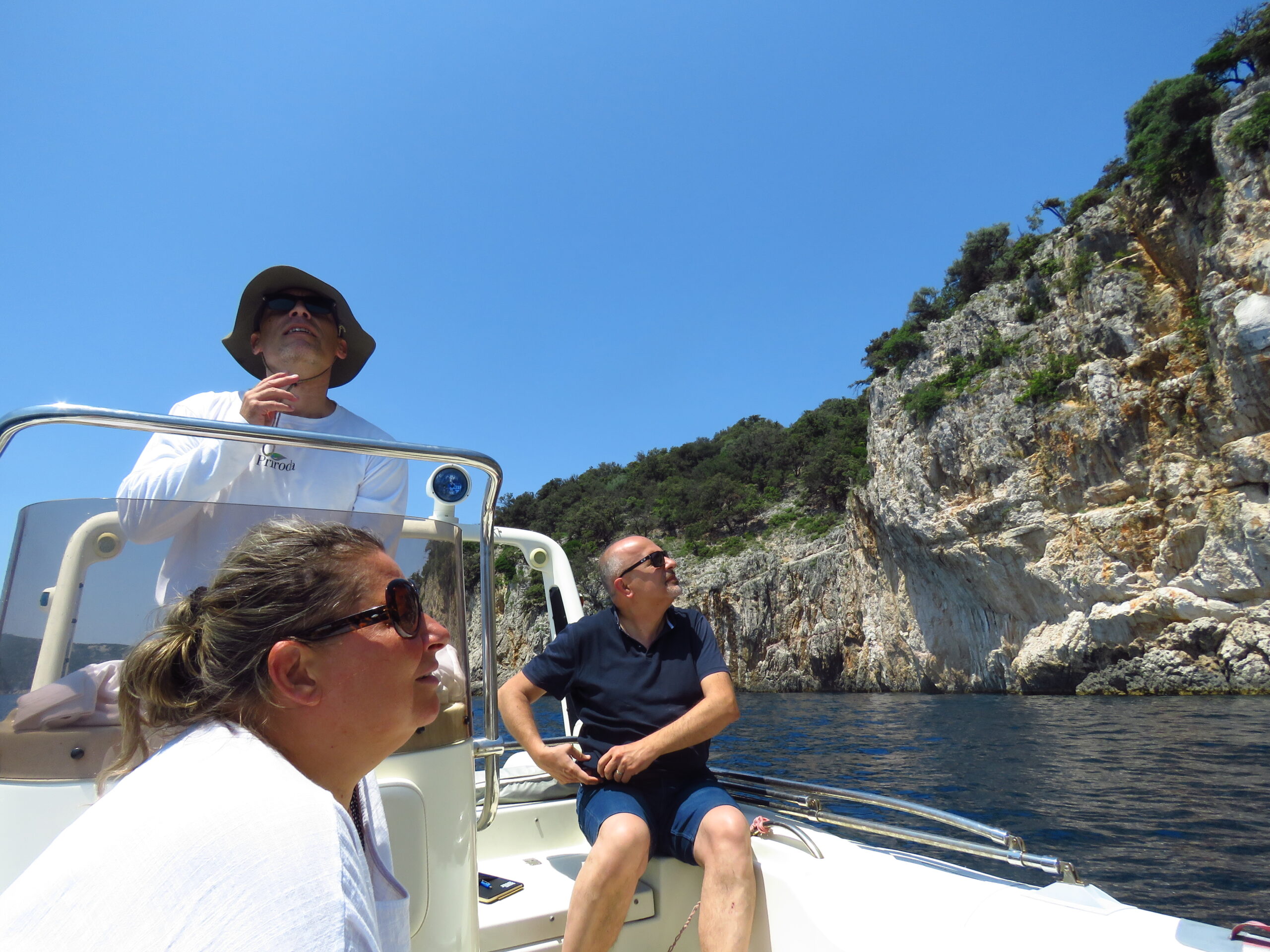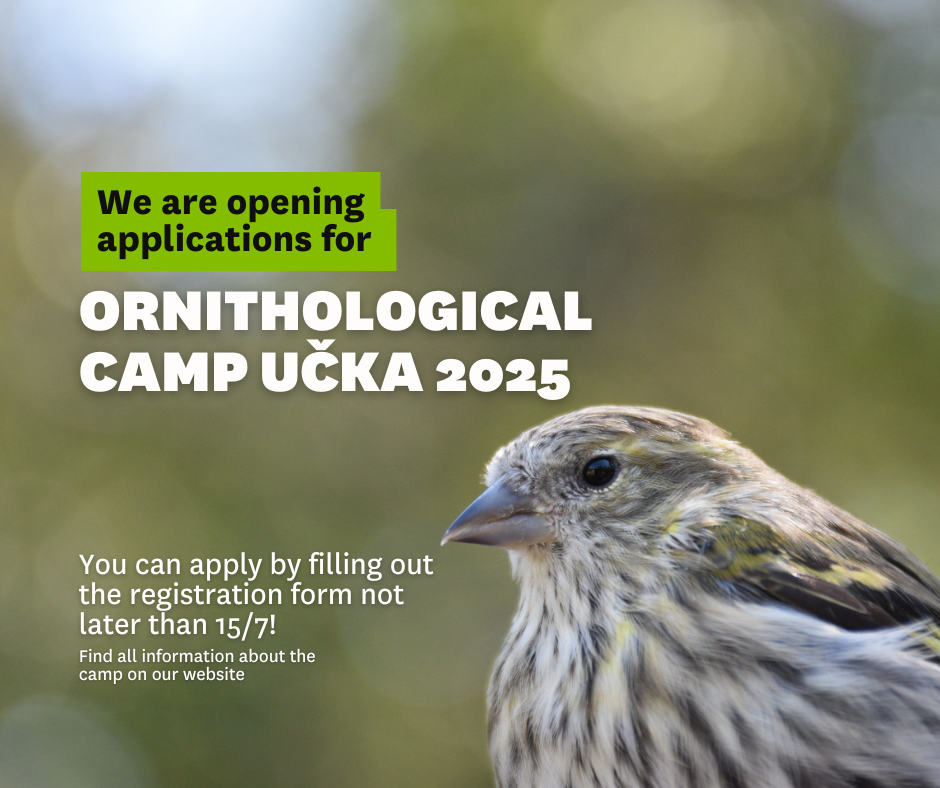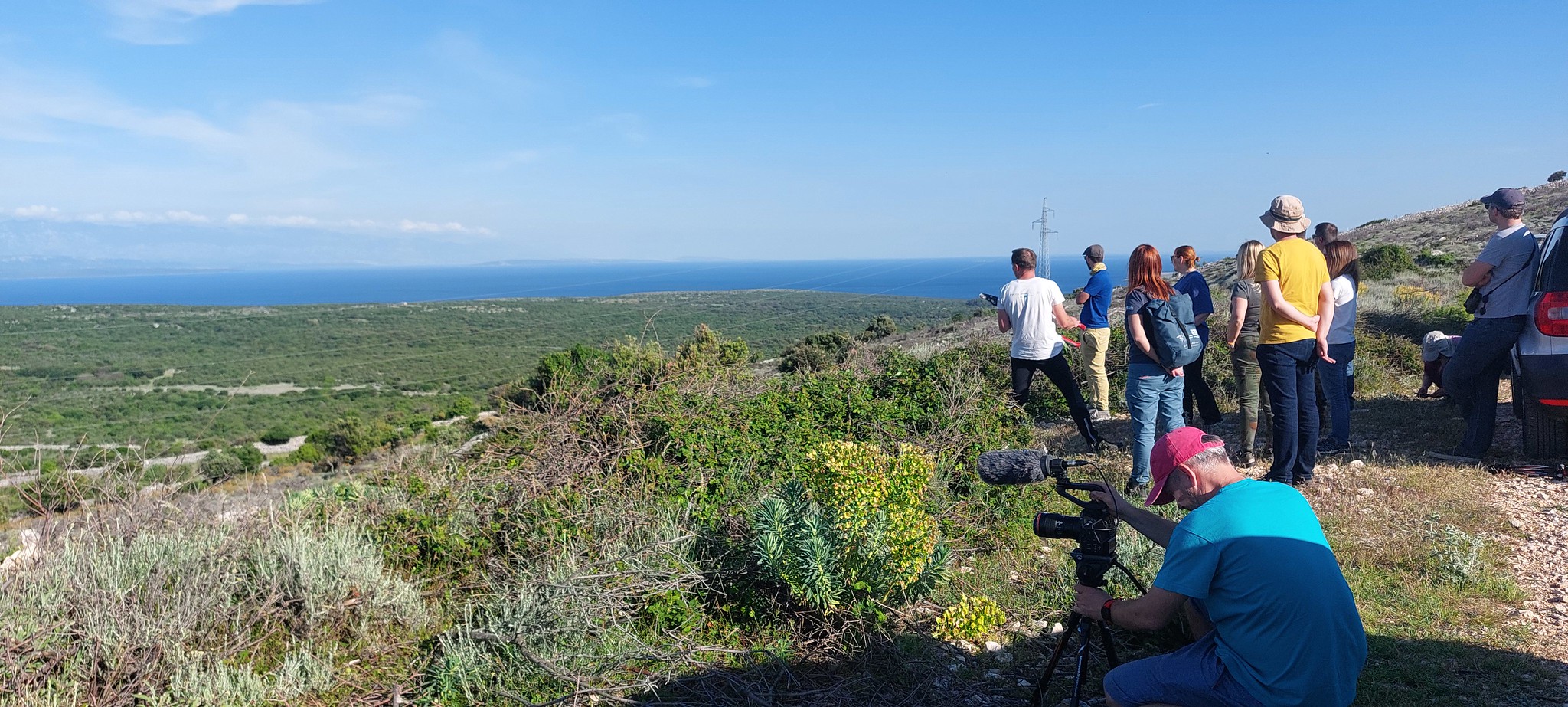The ornithological community, on initiative of the Association Biom from Zagreb, and the Croatian Society for the Protection of Birds and Nature, from Osijek, nominated three bird species for the 2024 bird of the year
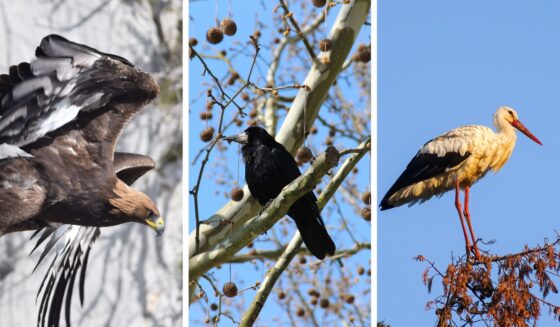
The vote for the bird of the year is open to the public and everyone who cares about the wellbeing of birds, their habitat, and biodiversity conservation in Croatia has a chance to vote for the bird of the year 2024.
How to take part? At the bottom of this page there is a
voting form where you can choose one of the three nominated species, by the 22
nd of November 2023.
Golden eagle (
Aquila chrysaetos)
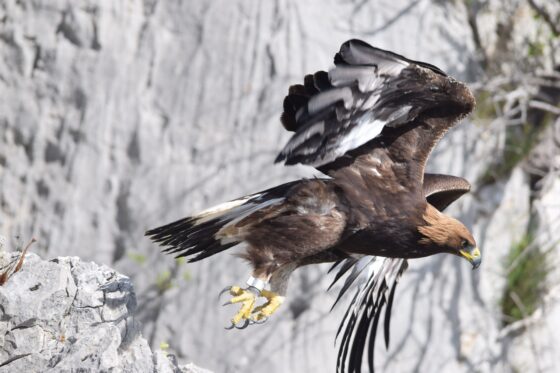
The golden eagle is a symbol of wilderness and it can be found on four continents – Africa, Asia, Europe, and North America. It is a brilliant predator and in order to have a sufficient amount of food, some breeding pairs have large territories, sometimes several tens of square kilometres. As an agile and strong predator, it can kill animals significantly heavier and larger that itself. Attacks on large birds such as swans and herons, as well as mammals like coyotes, chamois, and roe deer, are known. Like other large birds of prey, golden eagles are a long-lived species with some individuals being over 30 years old. They are consider juveniles for 5 years after which individuals become sexually mature. They may settle for many years with an individual of the opposite sex in suitable territory. Nowadays, golden eagle is an increasingly endangered species in Croatia. Alongside existing threats of poaching, lead poisoning due to use of lead ammunition in hunting, as well as other forms of poisoning, their biggest threat is habitat loss. On the one hand, open areas where these eagles hunt are disappearing due to continuing uncontrolled overgrowth, and on the other hand, there is an increased pressure to install renewable energy sources in the species’ distribution area – coastal and mountainous areas of Croatia.
Rook (
Corvus frugilegus)
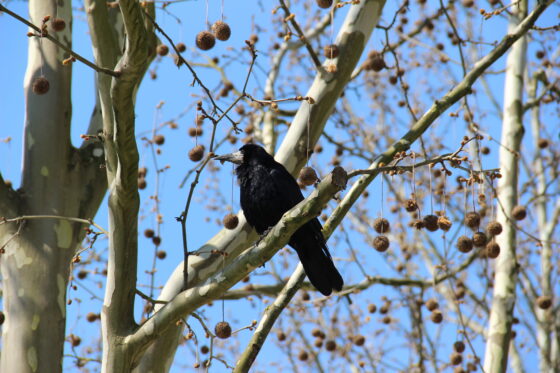
Rooks are one of our most noticeable and croaky neighbours that are not always popular among their human neighbours. It is a species from the corvid family recognisable by its black feathers with a blue or bluish-purple sheen, and a pointed grey bill. As other corvids, it stands out as an exceptionally intelligent bird, with complex social structures, and the ability to pass on knowledge and experiences to their offspring. It is a social but surprisingly timid bird, often found in flocks in fields, where they mostly feed on insects, small invertebrates, and plants. Their socialness is reflected in their nesting as well – rooks are considered colonial species as they nest in groups (rookeries), and nesting sites are filled with densely packed nests in airy treetops of tall trees. Over the last 50 years, rooks have increasingly started nesting in cities, and their specific nesting behaviour (and the mess and noise that accompany it) presents a challenge to their fellow citizens. In cities, they find refuge from persecution (specifically hunting and targeted nest destruction), while they find food in open areas surrounding cities. Looking at their numbers in cities, one might conclude their numbers are increasing but the opposite is happening. There are fewer and fewer rooks as evidenced by their endangered status according to the IUCN list, which has changed from “Least Concern” to “Near Threatened” in the last five years. Therefore, it is necessary to approach our life with them strategically, adapting urban spaces in a way that will reduce conflict with citizens, as well as securing and protecting nesting sites away from human settlements. In this way, we are fighting against losing another species that was once common and widespread, and important for open type habitats.
White stork (
Ciconia ciconia)
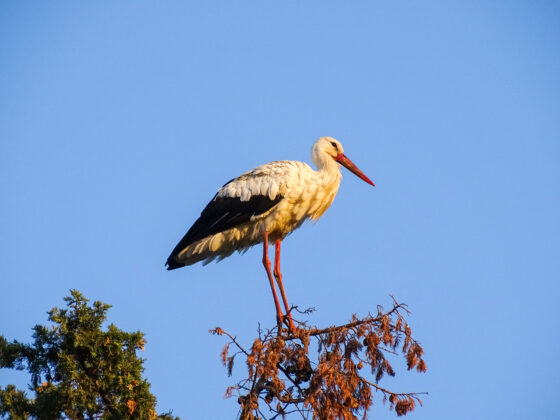
White storks are one of our most famous nesting birds due to their unique size and appearance as well as their nest which they build on roofs and electrical poles in human settlements. Nest site is closely related to feeding grounds as they feed in wet meadows and pastures, agricultural fields, and shallow swamps. Despite this, in Croatia they only nest in northern lowland areas, and they are not found in coastal or mountains areas. The use of pesticides and the intensification of agriculture, which lead to habitat loss and poor feeding grounds, are the main threats to the nesting population, while poaching on their migratory route, especially in the Middle East, is one of the biggest threats during their migration. A European census of white storks will take place in 2024, as it traditionally takes place every 10 years. Ten years ago, Croatia had 1741 recorded nesting pairs and the population is considered stable.
 The vote for the bird of the year is open to the public and everyone who cares about the wellbeing of birds, their habitat, and biodiversity conservation in Croatia has a chance to vote for the bird of the year 2024.
How to take part? At the bottom of this page there is a voting form where you can choose one of the three nominated species, by the 22nd of November 2023.
Golden eagle (Aquila chrysaetos)
The vote for the bird of the year is open to the public and everyone who cares about the wellbeing of birds, their habitat, and biodiversity conservation in Croatia has a chance to vote for the bird of the year 2024.
How to take part? At the bottom of this page there is a voting form where you can choose one of the three nominated species, by the 22nd of November 2023.
Golden eagle (Aquila chrysaetos)
 The golden eagle is a symbol of wilderness and it can be found on four continents – Africa, Asia, Europe, and North America. It is a brilliant predator and in order to have a sufficient amount of food, some breeding pairs have large territories, sometimes several tens of square kilometres. As an agile and strong predator, it can kill animals significantly heavier and larger that itself. Attacks on large birds such as swans and herons, as well as mammals like coyotes, chamois, and roe deer, are known. Like other large birds of prey, golden eagles are a long-lived species with some individuals being over 30 years old. They are consider juveniles for 5 years after which individuals become sexually mature. They may settle for many years with an individual of the opposite sex in suitable territory. Nowadays, golden eagle is an increasingly endangered species in Croatia. Alongside existing threats of poaching, lead poisoning due to use of lead ammunition in hunting, as well as other forms of poisoning, their biggest threat is habitat loss. On the one hand, open areas where these eagles hunt are disappearing due to continuing uncontrolled overgrowth, and on the other hand, there is an increased pressure to install renewable energy sources in the species’ distribution area – coastal and mountainous areas of Croatia.
Rook (Corvus frugilegus)
The golden eagle is a symbol of wilderness and it can be found on four continents – Africa, Asia, Europe, and North America. It is a brilliant predator and in order to have a sufficient amount of food, some breeding pairs have large territories, sometimes several tens of square kilometres. As an agile and strong predator, it can kill animals significantly heavier and larger that itself. Attacks on large birds such as swans and herons, as well as mammals like coyotes, chamois, and roe deer, are known. Like other large birds of prey, golden eagles are a long-lived species with some individuals being over 30 years old. They are consider juveniles for 5 years after which individuals become sexually mature. They may settle for many years with an individual of the opposite sex in suitable territory. Nowadays, golden eagle is an increasingly endangered species in Croatia. Alongside existing threats of poaching, lead poisoning due to use of lead ammunition in hunting, as well as other forms of poisoning, their biggest threat is habitat loss. On the one hand, open areas where these eagles hunt are disappearing due to continuing uncontrolled overgrowth, and on the other hand, there is an increased pressure to install renewable energy sources in the species’ distribution area – coastal and mountainous areas of Croatia.
Rook (Corvus frugilegus)
 Rooks are one of our most noticeable and croaky neighbours that are not always popular among their human neighbours. It is a species from the corvid family recognisable by its black feathers with a blue or bluish-purple sheen, and a pointed grey bill. As other corvids, it stands out as an exceptionally intelligent bird, with complex social structures, and the ability to pass on knowledge and experiences to their offspring. It is a social but surprisingly timid bird, often found in flocks in fields, where they mostly feed on insects, small invertebrates, and plants. Their socialness is reflected in their nesting as well – rooks are considered colonial species as they nest in groups (rookeries), and nesting sites are filled with densely packed nests in airy treetops of tall trees. Over the last 50 years, rooks have increasingly started nesting in cities, and their specific nesting behaviour (and the mess and noise that accompany it) presents a challenge to their fellow citizens. In cities, they find refuge from persecution (specifically hunting and targeted nest destruction), while they find food in open areas surrounding cities. Looking at their numbers in cities, one might conclude their numbers are increasing but the opposite is happening. There are fewer and fewer rooks as evidenced by their endangered status according to the IUCN list, which has changed from “Least Concern” to “Near Threatened” in the last five years. Therefore, it is necessary to approach our life with them strategically, adapting urban spaces in a way that will reduce conflict with citizens, as well as securing and protecting nesting sites away from human settlements. In this way, we are fighting against losing another species that was once common and widespread, and important for open type habitats.
White stork (Ciconia ciconia)
Rooks are one of our most noticeable and croaky neighbours that are not always popular among their human neighbours. It is a species from the corvid family recognisable by its black feathers with a blue or bluish-purple sheen, and a pointed grey bill. As other corvids, it stands out as an exceptionally intelligent bird, with complex social structures, and the ability to pass on knowledge and experiences to their offspring. It is a social but surprisingly timid bird, often found in flocks in fields, where they mostly feed on insects, small invertebrates, and plants. Their socialness is reflected in their nesting as well – rooks are considered colonial species as they nest in groups (rookeries), and nesting sites are filled with densely packed nests in airy treetops of tall trees. Over the last 50 years, rooks have increasingly started nesting in cities, and their specific nesting behaviour (and the mess and noise that accompany it) presents a challenge to their fellow citizens. In cities, they find refuge from persecution (specifically hunting and targeted nest destruction), while they find food in open areas surrounding cities. Looking at their numbers in cities, one might conclude their numbers are increasing but the opposite is happening. There are fewer and fewer rooks as evidenced by their endangered status according to the IUCN list, which has changed from “Least Concern” to “Near Threatened” in the last five years. Therefore, it is necessary to approach our life with them strategically, adapting urban spaces in a way that will reduce conflict with citizens, as well as securing and protecting nesting sites away from human settlements. In this way, we are fighting against losing another species that was once common and widespread, and important for open type habitats.
White stork (Ciconia ciconia)
 White storks are one of our most famous nesting birds due to their unique size and appearance as well as their nest which they build on roofs and electrical poles in human settlements. Nest site is closely related to feeding grounds as they feed in wet meadows and pastures, agricultural fields, and shallow swamps. Despite this, in Croatia they only nest in northern lowland areas, and they are not found in coastal or mountains areas. The use of pesticides and the intensification of agriculture, which lead to habitat loss and poor feeding grounds, are the main threats to the nesting population, while poaching on their migratory route, especially in the Middle East, is one of the biggest threats during their migration. A European census of white storks will take place in 2024, as it traditionally takes place every 10 years. Ten years ago, Croatia had 1741 recorded nesting pairs and the population is considered stable.
White storks are one of our most famous nesting birds due to their unique size and appearance as well as their nest which they build on roofs and electrical poles in human settlements. Nest site is closely related to feeding grounds as they feed in wet meadows and pastures, agricultural fields, and shallow swamps. Despite this, in Croatia they only nest in northern lowland areas, and they are not found in coastal or mountains areas. The use of pesticides and the intensification of agriculture, which lead to habitat loss and poor feeding grounds, are the main threats to the nesting population, while poaching on their migratory route, especially in the Middle East, is one of the biggest threats during their migration. A European census of white storks will take place in 2024, as it traditionally takes place every 10 years. Ten years ago, Croatia had 1741 recorded nesting pairs and the population is considered stable.




